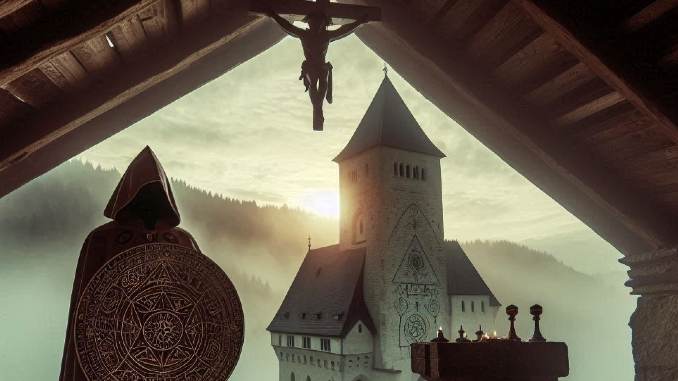
The Templars: Mysterious Keepers of Ancient Secrets
The Knights Templar, officially known as the “Poor Fellow-Soldiers of Christ and of the Temple of Solomon,” have captivated historians, mystics, and spiritual seekers for centuries. Founded as an order to protect the Holy Land, they remain shrouded in mystery, myth, and legend.
In this article, we delve into the enigmatic history of the Templars, explore their connection to the Grail legend, their possible ties to Mary Magdalene and the Cathars, and examine the mysterious Templar treasure that vanished without a trace. We will also address why Pope Clement V turned against this powerful order.
The Origins of the Templars and Their Spiritual Mission
The Templar Order was founded in 1119, following the First Crusade and the conquest of Jerusalem. Initially composed of only a few knights, the order was established by Hugh of Payens and a group of French noblemen. Their primary mission was to protect Christian pilgrims traveling to the Holy Land.
However, beyond their military purpose, the Templars seemed to have a deep spiritual orientation from the start. Their proximity to the ruins of Solomon’s Temple in Jerusalem, from which they derived their name, led many to speculate that they had uncovered secret knowledge that provided insight into the true nature of Christianity and higher spiritual knowledge.
The Disappearance of the Templar Treasure: Myth or Reality?
The Templars became known for their organization and influence, developing a powerful economic and financial system that brought them great wealth. However, this legendary Templar treasure mysteriously vanished after the order’s sudden dissolution.
- What was the Templar Treasure? It is believed that the Templar treasure was not only comprised of gold and silver but also religious artifacts, possibly including the Ark of the Covenant and, perhaps, the Holy Grail. Many believe this treasure included knowledge and writings that revealed hidden aspects of Christianity and profound esoteric wisdom.
- The Mystery of the Missing Treasure: After the Templar Order’s abrupt end in 1307, when many knights were arrested and later burned at the stake, the question of the treasure’s fate remained. Some speculate that the Templars hid the treasure before their capture, and that it has remained undiscovered to this day.
The Grail Legend and the Connection to Mary Magdalene

The legend of the Holy Grail is one of the most famous myths associated with the Templars. The Grail is said to be either the cup used by Jesus at the Last Supper or, in esoteric circles, a symbol of sacred knowledge and divine bloodlines.
- The Meaning of the Grail: In spiritual traditions, the Grail is often seen as a symbol of spiritual awakening and the eternal quest for divine truth. It represents not only physical objects but also a deep spiritual journey towards truth and enlightenment.
- Mary Magdalene and the Grail: In esoteric and Gnostic circles, it is often believed that Mary Magdalene plays an essential role in this legend. Some suggest that the Templars possessed knowledge of Mary Magdalene’s true identity and role in the early church. She is thought to have been not only a companion of Jesus but also his spiritual partner and the bearer of a sacred bloodline. This theory suggests that the “true Grail” may indeed be Mary Magdalene herself and her descendants, carrying the spiritual legacy of Jesus.
The Cathars and Their Spiritual Secrets
Another intriguing connection of the Templars lies with the Cathars, a religious group that flourished in southern France during the 12th and 13th centuries and was persecuted as heretical by the Pope. The Cathars practiced a dualistic faith, viewing the material world as the work of a malevolent force.
- Parallels with the Templars: Many historians and mystics see connections between the Cathars and the Templars. The Cathars believed in a higher spiritual knowledge free from the dogmas of the Catholic Church, and they revered Mary Magdalene as a spiritual mother figure.
- The Legend of Montségur: The Cathar fortress of Montségur in southern France is said to have played a role in safeguarding the Templar treasure. When the Cathars were defeated by Catholic forces in 1244, a small group reportedly escaped the fortress with sacred documents or artifacts. It is speculated that the Templars helped in this escape and that parts of their secret knowledge may have been connected to the Cathars.
Why Did the Pope Turn Against the Templars?
The downfall of the Templar Order began when Pope Clement V and King Philip IV of France acted together to dismantle the order. But why would the Pope persecute an order that had defended and supported the Church for centuries?
- Power and Political Interest: King Philip IV owed a large sum of money to the Templars and saw the order’s wealth as an opportunity to solve his financial troubles. At the same time, he feared the power of the Templars, which threatened his own authority as king.
- Accusations of Heresy: The Pope and the King accused the Templars of heresy, claiming they practiced secret rituals that betrayed the Christian faith. The Templars were alleged to worship idols and possess heretical knowledge, which threatened the Church’s control. It is possible that the Templars’ secret knowledge or their possible connections to the Cathars deeply unsettled the Catholic Church.
- The Spiritual Power of the Templars: Some historians believe that the Templars’ spiritual independence and their proximity to mystical knowledge and sacred secrets led the Church and the Pope to see the order as a threat. The Templars were rumored to possess knowledge of spiritual practices and perhaps even the true nature of Jesus and Mary Magdalene, which could have challenged Church doctrines.
The Spiritual Significance of the Templars Today
For spiritual seekers, the Templars represent a tradition of inner knowledge, spiritual strength, and sacred service. The Templars are a symbol of the power that lies within us all to seek deeper knowledge, embrace spiritual wisdom, and have the courage to seek truth beyond mainstream beliefs.
- The Quest for the Grail: In a spiritual context, the search for the Holy Grail symbolizes the personal journey towards self-knowledge and higher awareness. The Grail represents the pursuit of purity and the desire to attain divine wisdom.
- Enlightenment and Protection of Knowledge: The Templars, and their possible connections to Mary Magdalene and the Cathars, are a reminder to modern spiritual seekers to protect the ancient knowledge and spiritual values that are at risk of being lost in our modern world.
- The Feminine Power and Spiritual Balance: Honoring Mary Magdalene and the significance the Templars placed on her symbolizes the need to balance the feminine and the masculine, the spiritual and the physical, the light and the shadow. For spiritual seekers, this is an invitation to awaken their own potential and harmonize these dualities within themselves.
Conclusion: The Templars as Guardians of Ancient Mysteries
The Templars are a fascinating chapter in the history of spirituality, marked by mysteries, sacred secrets, and a deep connection to spiritual knowledge of the past. Their ties to Mary Magdalene, the Grail, and the Cathars hint that the order was more than just a military protector but also a guardian of profound spiritual wisdom.
The fall of the Templars remains an enduring mystery that continues to captivate imaginations. For spiritual seekers, the story of the Templars is a reminder of the power of inner knowledge.
13.04.2024
Uwe Taschow
Alle Beiträge des Autors auf Spirit OnlineAs a writer, I think about life. My own stories tell me who I am, but also who I can be. I wring insights from life in order to shape, to recognize truths that are worth writing for. That’s one of the reasons why I work as co-editor of the online magazine Spirit Online.





